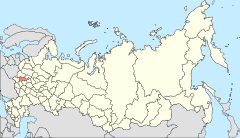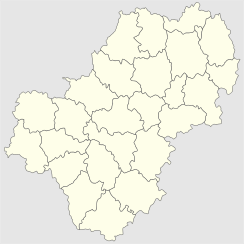- Dugna
-
Dugna (English)
Дугна (Russian)- Urban-type settlement[citation needed] - 
Location of Kaluga Oblast in RussiaCoordinates: 54°24′N 36°51′E / 54.4°N 36.85°ECoordinates: 54°24′N 36°51′E / 54.4°N 36.85°E Administrative status Country Russia Federal subject Kaluga Oblast Administrative district Ferzikovsky District[citation needed] Municipal status Municipal district Ferzikovsky Municipal District[citation needed] Urban settlement Dugna Urban Settlement[citation needed] Administrative center of Dugna Urban Settlement[citation needed] Statistics Population (2010 Census,
preliminary)667 inhabitants[1] Population (2002 Census) 792 inhabitants[2] Time zone MSD (UTC+04:00)[3] Founded 1709[citation needed] Postal code(s) 249811[citation needed] Dialing code(s) +7 484[citation needed] Dugna (Russian: Дугна́) is an urban locality (an urban-type settlement) in Ferzikovsky District of Kaluga Oblast, Russia, located on the left bank of the Dugna River, 18 kilometers (11 mi) from Ferzikovo, on the main rail line between Kaluga and Tula. Population: 667 (2010 Census preliminary results);[1] 792 (2002 Census);[2] 946 (1989 Census).[4]
Contents
History
The Dugna Foundry was first mentioned in 1689. The settlement itself was founded in 1709 by Nikita Demidov, who built the first steel mills in Russia. The steel mills were built in 1715 on the site of L. Naryshkin Iron Works, founded in 1690. Now the ironworks are known as Dugna Machine Plant[5]
Having arrived to Kaluga region in 1700, Nikita Demidov was well aware of its riches and of the importance of the steel industry for the economy of Russia. With the personal guarantee of Peter the Great, he was one of the pioneers to develop Russian domestic metallurgy and metal production. In the mid-18th century, Dugna, Brynsky, and Vyrovsky plants annually produced 19,000 poods of iron for the local market and additionally exported large quantities to St. Petersburg. Production of iron at these three factories at that time ranged from 40 to 70 thousand poods a year, which corresponded to melting of approximately 60-100 thousand poods of iron.
Dugna was granted urban-type settlement status in 1925.
Places of interest
- Peter & Paul Church (built about 1764).[6]
- Pontoon bridge over the Oka River.
- Steel pedestrian bridge over the Dugna River.
Gallery
References
- ^ a b Федеральная служба государственной статистики (Federal State Statistics Service) (2011). "Предварительные итоги Всероссийской переписи населения 2010 года (Preliminary results of the 2010 All-Russian Population Census)" (in Russian). Всероссийская перепись населения 2010 года (All-Russia Population Census of 2010). Federal State Statistics Service. http://www.perepis-2010.ru/results_of_the_census/results-inform.php. Retrieved 2011-04-25.
- ^ a b Федеральная служба государственной статистики (Federal State Statistics Service) (2004-05-21). "Численность населения России, субъектов Российской Федерации в составе федеральных округов, районов, городских поселений, сельских населённых пунктов – районных центров и сельских населённых пунктов с населением 3 тысячи и более человек (Population of Russia, its federal districts, federal subjects, districts, urban localities, rural localities—administrative centers, and rural localities with population of over 3,000)" (in Russian). Всероссийская перепись населения 2002 года (All-Russia Population Census of 2002). Federal State Statistics Service. http://www.perepis2002.ru/ct/doc/1_TOM_01_04.xls. Retrieved 2010-03-23.
- ^ Правительство Российской Федерации. Постановление №725 от 31 августа 2011 г. «О составе территорий, образующих каждую часовую зону, и порядке исчисления времени в часовых зонах, а также о признании утратившими силу отдельных Постановлений Правительства Российской Федерации». Вступил в силу по истечении 7 дней после дня официального опубликования. Опубликован: "Российская Газета", №197, 6 сентября 2011 г. (Government of the Russian Federation. Resolution #725 of August 31, 2011 On the Composition of the Territories Included into Each Time Zone and on the Procedures of Timekeeping in the Time Zones, as Well as on Abrogation of Several Resolutions of the Government of the Russian Federation. Effective as of after 7 days following the day of the official publication).
- ^ "Всесоюзная перепись населения 1989 г. Численность наличного населения союзных и автономных республик, автономных областей и округов, краёв, областей, районов, городских поселений и сёл-райцентров. (All Union Population Census of 1989. Present population of union and autonomous republics, autonomous oblasts and okrugs, krais, oblasts, districts, urban settlements, and villages serving as district administrative centers.)" (in Russian). Всесоюзная перепись населения 1989 года (All-Union Population Census of 1989). Demoscope Weekly (website of the Institute of Demographics of the State University—Higher School of Economics. 1989. http://demoscope.ru/weekly/ssp/rus89_reg.php. Retrieved 2010-03-23.
- ^ Дугнинский механический завод // rusten.ru
- ^ http://sobory.ru/article/index.html?object=07554
External links
Categories:- Urban-type settlements in Kaluga Oblast
Wikimedia Foundation. 2010.




